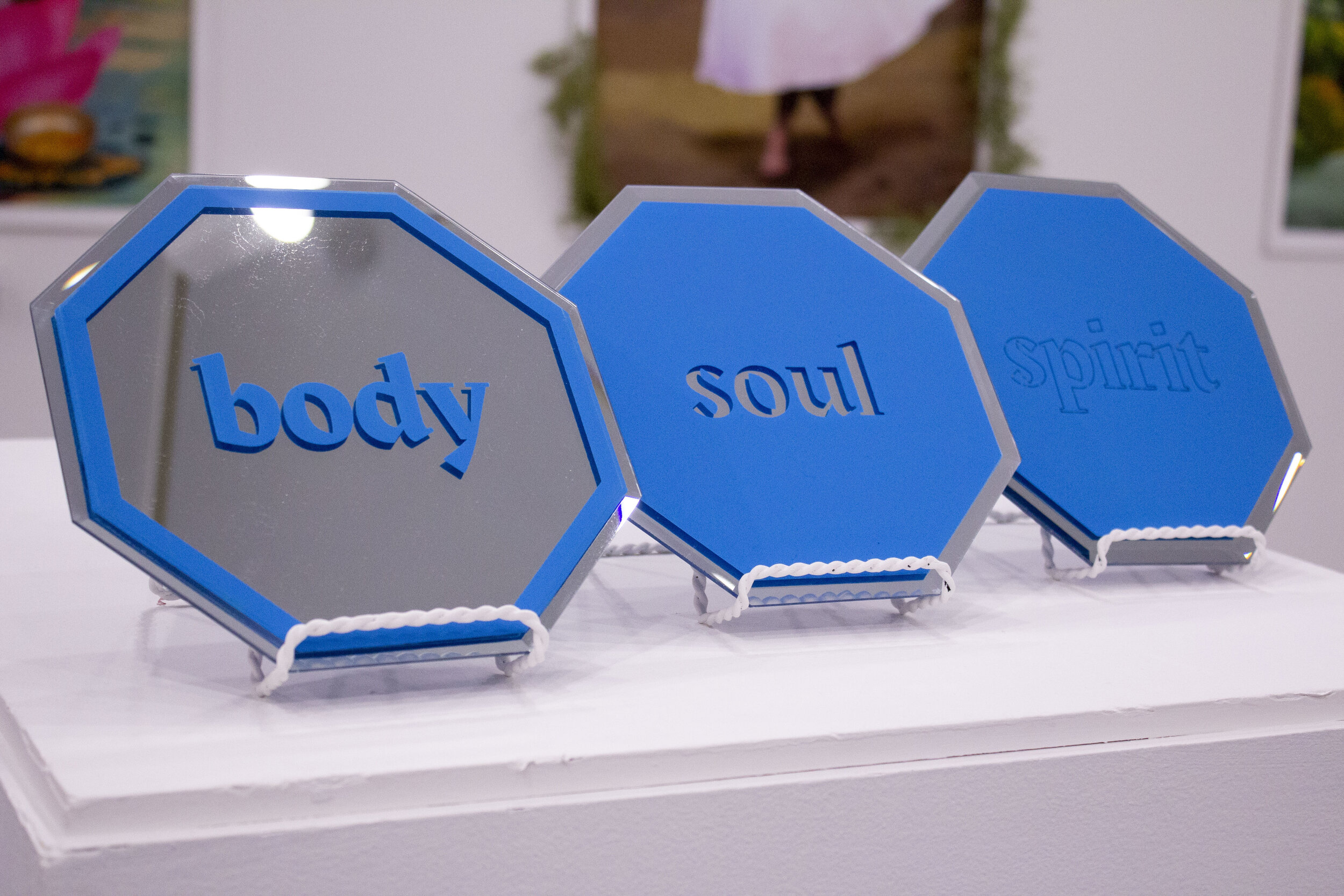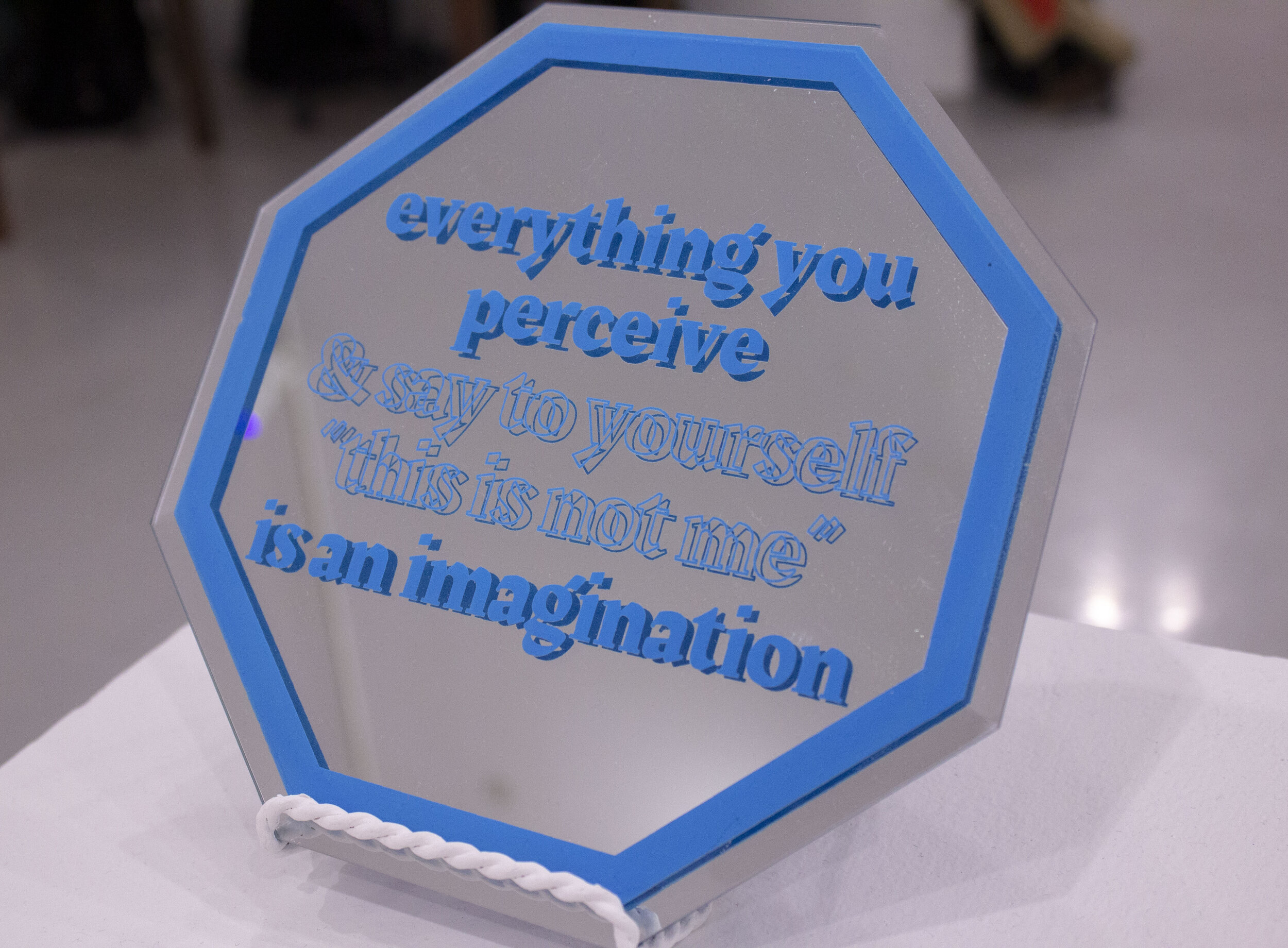
Design Thesis Installation, 2019: graphic design, printmaking, book design, exhibit / environmental
The World of the Souls is a walk-through pond that uses some visual language from Islamic gardens and research from Islamic mysticism to create an immersive pathway for contemplation of the self. It explores the self both physically and metaphysically, searching beyond the body for answers on how to come to terms with oneself.
Context: 1 year; BFA Design Thesis at Rutgers University Mason Gross School of the Arts
The World of the Souls

Goal
According to sufism, when we get to know ourselves, we get to know others. Focusing on the self as merely a body can be harmful and negligent, leaving one to constantly be in a state of pain and anger. Allowing the viewer to confront themselves through a journey to learn about themselves beyond their body and physical self, we can better navigate our lives and understand our actions.

What are you?
If someone thinks that I’m extroverted, but see myself as introverted, who is right? Why do people get angry so easily? These are questions that I was asking myself, and I began by exploring psychology–but it left me unsatisfied.


Using “The Silent Theology” of Islamic Art
The “most tangible and outward manifestations of the Islamic tradition represent its most subtle, inward, and essential realities. Hence, it seems it is better to show than to tell.” To many, the profound beauty and experience of Islamic art is stronger than words–that’s why this walk-through pond was created to allow the viewer to contemplate themselves, give them space to reflect inward, and feel divine beauty.






Research
Islamic gardens are the visual inspiration because they allude to (though do not represent) paradise/ eternal self
Human beings are made of water by 60%, additionally it quenches the soul's thirst (physical and metaphysical), is reflective, and references "gardens wherein rivers flow" i.e., paradise/ eternal self
Process
After months of research of psychology, sufism, and Islamic art and gardens, the first mockups presented a pond with a stepping stone pathway and five stages on getting to know yourself with pedestals. Similarly, there are five pillars in Islam.

Thesis mockup I A long and wide walkthrough pond to have an immersive experience

Thesis mockup II A long, narrow pond with staggered destinations

Thesis mockup III A single path for accessibility purposes

Mockup IV–A life size 21ft x 4.5ft mockup was created on paper to test the piece's placement in real life.


Content
The pedestal stages take the viewer through a journey of understanding the self. Four stages include screen-printed mirrors, and one stage features a book with screen-printed reflective sheets.

Stage 1: The first stage introduces the self as a subjective thing, allowing the viewer to question themselves metaphysically. What we tend to forget, is that we are not a reality. God is the Ultimate Reality, and anything else is subjective and indefinite. Therefore, when I say to myself "I am (xyz)" it can fundamentally neither be true nor false.

Stage 2: This stage introduces three parts of the self according to Islamic mysticism, and allows the viewer to question those things in relation to visuals. The "body" mirror allows for the viewer to see themselves, whereas "soul" has a lesser view as it is an inner dimension, and in "spirit" the viewer can rarely see themself as this is the most inner dimension of the self.

Stage 3: This stage invites the viewer to ask themselves how they see their body, soul, and spirit in relation to one another.
Stage 4: After the viewer is introduced to the topic with the previous stages, they are invited to read about themselves. This book uses Imam al-Ghazali's Alchemy of Happiness to give more details on what we are and how we can balance ourselves according to Islamic mysticism. For an in-depth read of the book click on the image!

Stage 5: The final stage blocks out the viewer's face to make them question who they are beyond their body. When I look at myself in the mirror, but I don't see the reflection of my body–what am I? And what am I looking at, or who am I looking at?
Final Process & Construction
Pond Color: Yucatan blue paint and primer with enamel finish
Pattern Color: Satin aqua spray paint
Pattern: Islamic art is meant to make things metaphysically transparent, allows for contemplation, is timeless, and helps bring souls to balance. The six-pointed stars alludes to natural surroundings.

A hand-cut stencil was made of the pattern design

Several boards of plywood were painted and stenciled with the pattern, then hand painted for alterations

Nails were then screwed the wood boards together

The holes were then filled with wood biscuits

Then, the pieces was sanded down

Silicone was used to seal the edges


The seams were then repainted and stenciled

Lastly, stepping stones were placed and eight gallons of clear resin were poured. Then, the pedestals were placed after 24 hours.
Why resin instead of water?
One of the references to buildings in the Qur'an is in suraal-Nand (27.15-44.). Here, the Queen of Sheba visits King Solomon, and when she enters the palace and comes across the floor of reflective material, it looks like water. She is so convinced that she lifts her skirt. The glass floor was a popular device in several palaces in the Islamic world where people would trick others with architecture to think there was water.
Source: Islamic Aesthetics by Oliver Leaman








